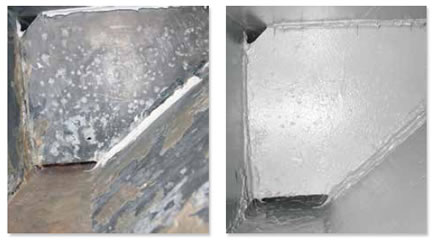When it comes to onboard water tanks, we prefer stainless, fiberglass, and even roto-molded tanks (in that order) to aluminum ones. Aluminum tanks tend to pit and corrode over time, often needing to be replaced.
The insides of the two 60-gallon aluminum water tanks in our 30-year-old Valiant 40 were more like a nasty moonscape than a drinking source. Their surfaces were pitted and rusted from what looked like a reaction to long-time use of chlorine.
A previous owner cut several 10-inch by 10-inch inspection holes to gain access to the tanks and coated the tank interiors with epoxy. The forward covers were made from aluminum, and the aft covers of clear acrylic. All covers were installed with 5/16-inch bolts, spaced on 3-inch centers, threaded into the tank.

Photos by Patrick Childress
Water from these tanks always tasted like plastic, but to remove the deteriorating tanks from the boat, we would have to cut each one into small pieces, and their replacements would have to be much smaller to fit through the companionway.
Although aluminum is notoriously difficult to paint, we began researching this option. Another Valiant 40 owner pointed us in the direction of a product he had used: Amerlock2, a two-part paint made by Amercoat. It is the same paint used inside municipal water towers.
We knew that preparing aluminum for painting is the most difficult part. First, we had to chip, scrape, wire brush, and sand away all the old resin coating . This was a time-consuming and tedious process. Once everything was removed, we used a palm sander to thoroughly smooth the insides of the tanks with 100-grit paper. Special attention was given to pitted areas. In the most corroded areas, we puttied Marinetex into the indentions to rebuild the thickness of the aluminum. After the Marinetex was cured, we sanded it with 100-grit paper.
In their liquid form, vapors from the two-part Amerlock2 are very toxic. Simply using fans to blow away fumes is not enough. The best solution is piping in fresh air to a full-face mask; the equipment is well worth the expense to rent. In our case, we were able to breathe through the mouthpiece of our 12-volt hookah, normally used for shallow-water diving. We also directed fans to blow fresh air through the boat.
Since completing this project, we learned that there are more acceptable food grade, two-part paints designed specifically for potable water systems, including: Rust-Oleum W9200 System Potable Water Coating; Hempel Hempadure 3556; and Sherwin Williams Tank Clad HS Epoxy.
We did not prime the tanks. After mixing the two-part paint, we applied it directly to the aluminum, making sure the surface was free of oxidation. Wearing a long-sleeve shirt and rubber gloves, we used a very skinny sheepskin roller to apply the paint to large areas. The coating was applied without thinning. A $10, 1.5-inch natural bristle paint brush filled in the tanks hard-to-reach corners and also coated the adhesive sealant we added around the baffle. We discovered that a cheap China bristle or chip brush could not be used because the bristles tended to fall out into the work.
We soaked extra paint into the deteriorating areas of aluminum to smooth out voids and build up thickness. After applying at least two coats of paint, we let the tanks cure for four days, then reinstalled the inspection covers using clear silicone as a sealant.
Conclusion
After seven years of use, the Amerlock2 is still doing what it was designed to do. One additional perk is that we can now add chlorine to our water tanks to ward off algae and microbial growth without hesitation. As we know, adding chlorine to bare aluminum and stainless-steel tanks will, over time, pit the tanks.
One other advantage to having clear 3/8-inch acrylic inspection ports on water tanks is that we can see how much water is left and exactly what we are drinking. The ports also allow us to inspect the coating integrity. Getting a coating to permanently adhere inside a water tank can be a challenge, so the coating needs to be inspected regularly.





































We are thinking of coating our aluminum water tanks. Would be interesting to know the condition of the paintwork after all these years
Mark,
You can check in with Rebecca at http://whereisbrickhouse.com/. Sadly, the author of this archive article, Patrick Childress, died of COVID last year. https://www.practical-sailor.com/brief/patrick-childress-sailor-extraordinaire
Fuel tanks (20gal x 2) on my 40 year old Olson 40 have pitting corrosion but no leaks. The pit depth appears to be minimal. Are the treatments shown here for water tanks appropriate for diesel
fuel tanks?
Thanks,
Tom